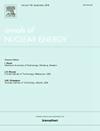Enhancement on optical properties and radiation shielding performance of new formulation zinc modified boro-tellurite glasses
IF 1.9
3区 工程技术
Q1 NUCLEAR SCIENCE & TECHNOLOGY
引用次数: 0
Abstract
The main goal of this research is to determine the fundamental characteristics of xZnO − 30B2O3−(70-x)TeO2 glass system that can be used as radiation shielding. Ultrasonic analysis and UV–Vis results show Urbach energy ranges from 1.071 to 0.737 S-1, whereas the direct and indirect optical band gaps increase between 3.194 and 3.270 and 2.22 to 2.64 eV, respectively. The density of the glasses varies between 4.25 and 4.04 g/cm3. As the ZnO concentration increases, all elastic moduli decrease as well as microhardness from 5.63 to 3.92 GPa and Poisson’s ratio from 0.26 to 0.24 based on the results from ultrasonic measurement. The refractive index of a glass changes from 1.98 to 2.02, their molar volume decreases from 32.77 to 28.91 cm3/mol, and molar weight decreases from 132.61 to 116.96 g/mol, whereas oxygen molar volume ranges from 12.1 to 9.73, and the oxygen packing density changes from 2.3 to 2.1 mol/cm3. Electronegativity, Optical Polarizability, and Basicity ranging from 0.86 to 0.87, 2.73 to 2.71, and 1.27 to 1.26, respectively. All the radiation factors for the robust glass system were calculated using the Phy-X/PSD programming.
求助全文
约1分钟内获得全文
求助全文
来源期刊

Annals of Nuclear Energy
工程技术-核科学技术
CiteScore
4.30
自引率
21.10%
发文量
632
审稿时长
7.3 months
期刊介绍:
Annals of Nuclear Energy provides an international medium for the communication of original research, ideas and developments in all areas of the field of nuclear energy science and technology. Its scope embraces nuclear fuel reserves, fuel cycles and cost, materials, processing, system and component technology (fission only), design and optimization, direct conversion of nuclear energy sources, environmental control, reactor physics, heat transfer and fluid dynamics, structural analysis, fuel management, future developments, nuclear fuel and safety, nuclear aerosol, neutron physics, computer technology (both software and hardware), risk assessment, radioactive waste disposal and reactor thermal hydraulics. Papers submitted to Annals need to demonstrate a clear link to nuclear power generation/nuclear engineering. Papers which deal with pure nuclear physics, pure health physics, imaging, or attenuation and shielding properties of concretes and various geological materials are not within the scope of the journal. Also, papers that deal with policy or economics are not within the scope of the journal.
 求助内容:
求助内容: 应助结果提醒方式:
应助结果提醒方式:


